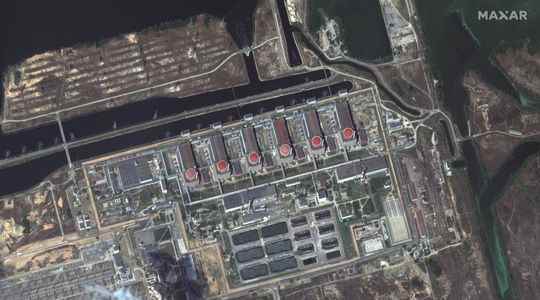This Friday, March 4, at the other end of the wire that connects him to Emmanuel Macron, Mariano Grossi hides his feverishness badly. On the 9th day of the Russian invasion of Ukraine and as strikes hit administrative buildings adjoining the Zaporizhia nuclear site in the south-east of the country overnight, the head of the International Atomic Energy Agency (IAEA) and all of Europe hold their breath. The ghost of Chernobyl hovers. The risk of accident is not to be excluded on this gigantic power station equipped with six reactors.
Six months later, the situation remains extremely tense. During the night of Thursday to Friday, the power supply of the power station was temporarily suspended for the first time in its history, because of a fire attributed by Ukraine to the Russian occupier. A situation putting the plant’s cooling systems in a vulnerable situation for several hours. This Monday, IAEA experts are going there to assess the situation, a first since the start of the conflict. The message addressed in March by Mariano Grossi to the French president remains more relevant than ever: “If there were a problem, the repercussions would be terrible and far beyond the military conflict itself. I think that the the future of nuclear power itself would be seriously compromised.”
Paradoxically, when it is this same war in Ukraine that has been pushing many countries for several months to reconsider the atom in their energy mix. With Zaporijia, could nuclear experience a new post-Fukushima winter? Within the sector, opinions are divided. “The accident at the Japanese plant had effects on certain countries such as Germany, the Netherlands and Austria. But what above all hurt the sector were the delays and the additional costs that have succeeded over the last decade”, nuance Valérie Faudon, director general of the French Society of Nuclear Energy (SFEN).
Pragmatic approach
“There is obviously concern, but governments seem to be adopting a pragmatic approach and this does not translate into a condemnation of nuclear power as such”, abounds the framework of a large international organization. The latter citing, for example, the position of Belgium, Japan, or even Germany, which have announced or are considering maintaining or relaunching their reactors. In the front line facing the risk of accident, “Ukraine itself signed an agreement in early June with the American Westinghouse to increase the number of reactor constructions, from five to nine”, specifies this same source.
On the side of the French Ministry of Energy Transition, we carefully avoid projecting ourselves into an accident-type scenario in Ukraine and its consequences on the relaunch of nuclear power in France. We have just pointed out the activism of Emmanuel Macron in recent months to promote the inspection of the plant by IAEA agents or the need for a dialogue between the operators and the authorities “to ensure the highest level of safety.” The President of the Republic has since had the opportunity to explain that it was necessary to protect “civilian nuclear power” at all costs.
More directly, this leader of a large French nuclear group judges that an accident could hinder the revival glimpsed in recent months: “In many countries, public opinion is convinced that civil nuclear power is not decorrelated from nuclear power. military use or the military use of nuclear power. The risk in Zaporizhia is to link these two subjects.” And thus to lend the flank to the speech of the opponents of nuclear power. Or to feed the fear of the populations around the proliferation of reactors around the world, which would then constitute as many sources of risk.
Plants not sized for war
In fact, “nuclear reactors are civilian industrial installations which are not designed to withstand all possible attacks in the event of a large-scale armed conflict”, warns Olivier Dubois, deputy director of safety expertise at the Institute for Radiation Protection and Nuclear Safety. There are of course attacks on the building targeting the reactor core, even if it is protected by a fairly robust concrete enclosure in the event of a plane crash, for example. “But in the event of an armed conflict, we can also, and perhaps above all, fear the loss of the electricity network to which the plant is connected or the loss of the source of cold water allowing the reactor to be cooled”, still judges the specialist. At Three Miles Island (United States), Fukushima (Japan) and Chernobyl (Ukraine), it was this lack of cooling that led to the melting of the reactor core, and radioactive releases into the environment (very limited in the first case).
On the side of Zaporijia, there is fortunately no radioactive release to deplore for the moment, or even a pre-accident situation. However, the tensions on the spot are unprecedented. Until now, no heavy weapon had ever targeted a nuclear power plant. Should the period of geopolitical instability therefore lead to the establishment of new standards integrating the risk of war? “In such cases, the nature of the aggressor changes but not the mapping of the risk associated with the operation. That of core meltdown has long been integrated by the operators”, nuances an expert. “Resistance to imaginable attacks in the event of a conflict can always be improved”, replies Olivier Dubois. With the key to new probable costs to be assumed. The acceptability of the atom, a sine qua non for its revival, will undoubtedly be at this price.
